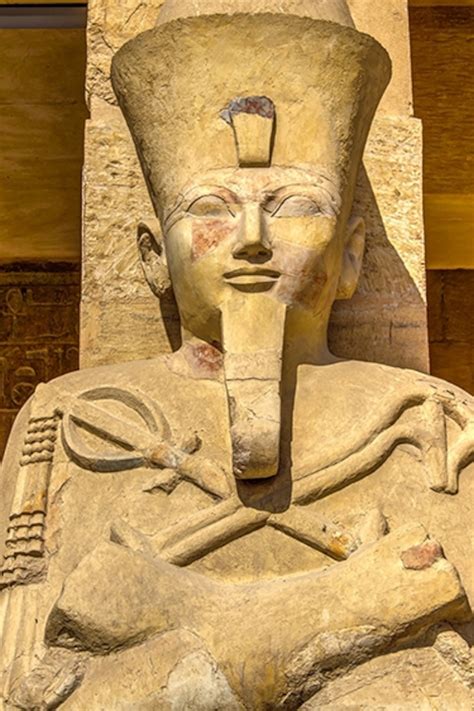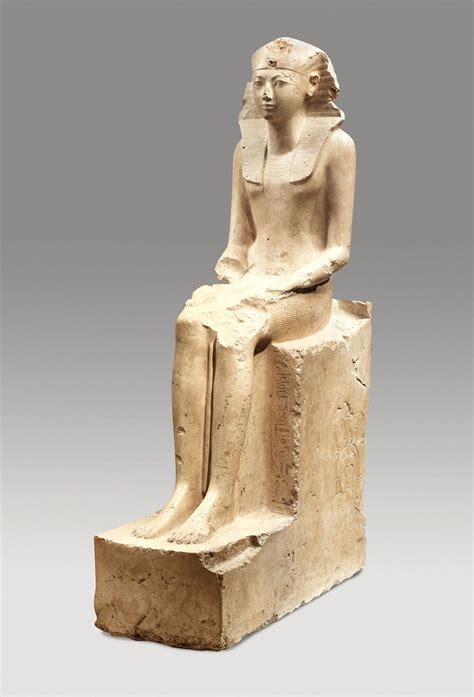
Queen Hatshepsut’s damaged statues, long attributed to a simple act of political vengeance by her successor Thutmose III, may actually be the result of a far more complex series of events involving religious reform, economic anxieties, and internal power struggles within the Egyptian elite, according to a new study.
Decades after the death of Hatshepsut, pharaohs attempted to erase the legacy of her reign by desecrating her statues and monuments. While it has been thought that her successor, Thutmose III, was driven by personal animosity and a desire to consolidate power, new research suggests a more nuanced explanation: a multi-faceted crisis encompassing religious and economic upheaval, as well as infighting among high-ranking officials, that culminated in the defacement of Hatshepsut’s image.
The conventional narrative surrounding Hatshepsut’s reign and its aftermath has always centered on Thutmose III’s alleged resentment towards his aunt and stepmother, who ruled as pharaoh for over two decades while he was still young. It was believed that upon his ascension to the throne, Thutmose III embarked on a systematic campaign to eradicate Hatshepsut’s memory from the historical record, thereby legitimizing his own rule and asserting his authority. The destruction and defacement of her statues and monuments were seen as the primary manifestations of this animosity.
However, recent investigations conducted by researchers indicate that this interpretation may be overly simplistic and fail to capture the full scope of the circumstances surrounding Hatshepsut’s damnatio memoriae. The new study suggests that a confluence of factors, including religious shifts, economic instability, and internal conflicts, contributed to the decision to target Hatshepsut’s legacy.
According to Dr. Kendra Craycraft, an Egyptologist who authored the study, the motives behind the destruction of Hatshepsut’s statues are likely more intricate than previously understood. “While the traditional explanation focuses on Thutmose III’s personal animosity towards Hatshepsut, our research suggests a more complex set of factors were at play,” Craycraft states. The study posits that religious reforms initiated during Hatshepsut’s reign, particularly those pertaining to the worship of the god Amun, may have sparked resistance from certain segments of the Egyptian priesthood and elite. Hatshepsut, like other pharaohs, devoted significant resources to the temples of Amun, and her close relationship with the priesthood was initially a source of strength. However, her policies may have inadvertently alienated more conservative elements within the religious establishment who felt that her reign was disrupting traditional religious practices.
Moreover, the study suggests that economic challenges during and after Hatshepsut’s rule could have contributed to the decision to erase her legacy. Hatshepsut’s ambitious building projects and military campaigns placed a strain on the Egyptian economy, leading to potential resentment among the population. The defacement of her monuments may have been seen as a way to alleviate economic grievances by symbolically rejecting her reign and its associated burdens.
Adding another layer of complexity, the research indicates that internal power struggles within the Egyptian elite may have played a significant role in Hatshepsut’s downfall. The pharaoh’s close advisors and officials were vying for influence and control, and the removal of Hatshepsut from the historical record may have been a way for these individuals to consolidate their power and advance their own agendas.
The defacement of Hatshepsut’s statues was not merely an act of personal vengeance by Thutmose III, but rather a calculated move driven by a confluence of religious, economic, and political factors. “It was a perfect storm of circumstances that ultimately led to the decision to erase Hatshepsut from history,” Craycraft explains.
To gain a deeper understanding of the events surrounding Hatshepsut’s damnatio memoriae, researchers have employed a variety of methods, including the analysis of inscriptions, archaeological evidence, and historical texts. By examining the patterns of damage to Hatshepsut’s statues and monuments, they have been able to discern that the destruction was not random or haphazard, but rather carefully planned and executed. This suggests that the individuals responsible for the defacement had a clear agenda and were determined to achieve specific objectives.
Furthermore, the study emphasizes the importance of considering the broader historical context in which Hatshepsut’s damnatio memoriae occurred. The 18th Dynasty of Egypt was a period of significant political, social, and religious change, and Hatshepsut’s reign was a pivotal moment in this transformative era. By examining the events of this period in their entirety, researchers can gain a more nuanced understanding of the motivations and consequences of Hatshepsut’s erasure from history.
One of the key findings of the study is that the defacement of Hatshepsut’s statues and monuments was not limited to a specific time period or geographic location. Evidence of the destruction has been found at various sites throughout Egypt, indicating that the campaign to erase Hatshepsut’s legacy was widespread and sustained over an extended period. This suggests that the decision to target Hatshepsut was not merely a fleeting impulse, but rather a deliberate and coordinated effort by those in power.
Moreover, the study challenges the conventional wisdom that Thutmose III was solely responsible for Hatshepsut’s damnatio memoriae. While Thutmose III undoubtedly played a role in the erasure of Hatshepsut’s legacy, the research suggests that he was not acting alone. Other high-ranking officials and members of the Egyptian elite likely participated in the campaign, driven by their own personal and political agendas.
The discovery of hidden inscriptions and artifacts has shed new light on the circumstances surrounding Hatshepsut’s reign and its aftermath. These discoveries have provided valuable insights into the motivations and intentions of those who sought to erase Hatshepsut from history.
For example, the discovery of a cache of statues hidden beneath the mortuary temple of Hatshepsut at Deir el-Bahri has revealed that some of her statues were deliberately buried and concealed, rather than simply destroyed. This suggests that there may have been a desire to preserve certain aspects of Hatshepsut’s legacy, even as her public image was being systematically dismantled.
The analysis of these hidden statues has provided valuable clues about the religious beliefs and political ideologies of the individuals who were involved in Hatshepsut’s damnatio memoriae. By examining the inscriptions and iconography on the statues, researchers have been able to discern that the motives behind the destruction were complex and multifaceted.
In addition to the discovery of hidden statues, the study also highlights the importance of examining the historical texts and inscriptions that were produced during and after Hatshepsut’s reign. These texts provide valuable information about the political and social climate of the time, as well as the attitudes and beliefs of the Egyptian elite.
For instance, the Amarna Letters, a collection of diplomatic correspondence from the reign of Akhenaten, provide insights into the political intrigues and power struggles that characterized the late 18th Dynasty. These letters reveal that the Egyptian court was rife with rivalries and conspiracies, and that the pharaoh’s authority was often challenged by powerful officials and foreign rulers.
By studying these historical texts, researchers can gain a deeper understanding of the forces that shaped Hatshepsut’s reign and its aftermath. They can also learn about the ways in which the Egyptian elite manipulated history and propaganda to advance their own interests.
The study’s findings have significant implications for our understanding of ancient Egyptian history and culture. By challenging the conventional narrative surrounding Hatshepsut’s damnatio memoriae, the research encourages us to reconsider the motivations and actions of the individuals who shaped the course of Egyptian history.
It also highlights the importance of considering the broader historical context when interpreting the events of the past. By examining the political, social, and economic factors that influenced Hatshepsut’s reign and its aftermath, we can gain a more nuanced understanding of the complexities of ancient Egyptian society.
Ultimately, the study suggests that the defacement of Hatshepsut’s statues was not simply an act of personal vengeance, but rather a complex and multifaceted event driven by a confluence of religious, economic, and political factors. By understanding these factors, we can gain a deeper appreciation of the challenges and opportunities that faced Hatshepsut and her contemporaries.
The study further suggests that the rewriting of history is an ongoing process, and that our understanding of the past is constantly evolving as new evidence is discovered and new interpretations are offered. By remaining open to new perspectives and challenging conventional wisdom, we can continue to refine our knowledge of ancient Egyptian history and culture.
The research also underscores the importance of interdisciplinary collaboration in the study of ancient history. By bringing together experts from different fields, such as archaeology, Egyptology, and history, we can gain a more comprehensive understanding of the past.
The study concludes by emphasizing the need for further research into the circumstances surrounding Hatshepsut’s damnatio memoriae. While the current research has shed new light on this important event, there are still many unanswered questions. By continuing to investigate the evidence and explore new interpretations, we can deepen our understanding of ancient Egyptian history and culture.
The legacy of Hatshepsut is complex and multifaceted. She was a powerful and ambitious ruler who defied convention and left an indelible mark on Egyptian history. Her reign was a time of peace, prosperity, and innovation, and her achievements are still celebrated today.
However, Hatshepsut’s legacy was also marred by controversy and conflict. Her decision to rule as pharaoh challenged the traditional gender roles of ancient Egypt, and her actions sparked opposition from some segments of Egyptian society.
The defacement of Hatshepsut’s statues and monuments was a tragic event that represents a loss for all of humanity. It is a reminder of the fragility of historical memory and the importance of preserving our cultural heritage.
Despite the attempts to erase Hatshepsut from history, her legacy has endured. She remains one of the most fascinating and enigmatic figures in ancient Egyptian history, and her story continues to captivate and inspire people around the world.
The study sheds light on the long-standing debate surrounding the destruction of Hatshepsut’s images. It invites scholars and enthusiasts alike to revisit established narratives and consider alternative perspectives.
Furthermore, it emphasizes the significance of understanding the multifaceted dynamics of power, religion, and economy in ancient societies. By examining the complexities of Hatshepsut’s reign and its aftermath, we can gain a deeper appreciation of the intricacies of human history.
Moreover, this research highlights the importance of critical analysis and the ongoing pursuit of knowledge. By questioning assumptions and seeking new evidence, we can refine our understanding of the past and challenge conventional wisdom.
The study also underscores the role of interdisciplinary collaboration in historical research. By bringing together experts from diverse fields, we can gain more comprehensive insights into the events and dynamics of ancient societies.
Ultimately, this research contributes to a richer and more nuanced understanding of Hatshepsut’s legacy and its significance in the context of ancient Egyptian history. It encourages us to explore the complexities of the past and to appreciate the multifaceted nature of human history.
The implications of this study are far-reaching and have the potential to reshape our understanding of ancient Egyptian history. By challenging the conventional narrative surrounding Hatshepsut’s damnatio memoriae, the research opens up new avenues for inquiry and encourages us to reconsider the motivations and actions of the individuals who shaped the course of Egyptian history.
It also highlights the importance of considering the broader historical context when interpreting the events of the past. By examining the political, social, and economic factors that influenced Hatshepsut’s reign and its aftermath, we can gain a more nuanced understanding of the complexities of ancient Egyptian society.
Furthermore, the study emphasizes the need for further research into the circumstances surrounding Hatshepsut’s damnatio memoriae. While the current research has shed new light on this important event, there are still many unanswered questions. By continuing to investigate the evidence and explore new interpretations, we can deepen our understanding of ancient Egyptian history and culture.
Dr. Craycraft’s work provides a valuable contribution to the field of Egyptology and offers a fresh perspective on a pivotal moment in ancient Egyptian history. Her meticulous analysis and comprehensive research shed light on the complex interplay of factors that led to the erasure of Hatshepsut’s legacy.
The study serves as a reminder that history is not static, but rather a dynamic and evolving narrative that is constantly being reshaped by new discoveries and interpretations. By challenging conventional wisdom and encouraging critical analysis, this research contributes to a more nuanced and comprehensive understanding of the past.
Moreover, the study highlights the importance of preserving and protecting our cultural heritage. The defacement of Hatshepsut’s statues is a stark reminder of the fragility of historical memory and the potential for cultural loss. By safeguarding our monuments and artifacts, we can ensure that future generations have the opportunity to learn from the past and appreciate the richness and diversity of human history.
The research also underscores the significance of interdisciplinary collaboration in the study of ancient history. By bringing together experts from different fields, such as archaeology, Egyptology, and history, we can gain a more comprehensive understanding of the past.
The study concludes by emphasizing the need for continued research into the complexities of ancient Egyptian history. While the current research has shed new light on Hatshepsut’s damnatio memoriae, there are still many unanswered questions. By continuing to investigate the evidence and explore new interpretations, we can deepen our understanding of ancient Egyptian history and culture.
The case of Hatshepsut serves as a powerful example of how history can be manipulated and rewritten to serve the interests of those in power. It also highlights the importance of critical thinking and the need to question established narratives.
By examining the motivations and actions of the individuals who sought to erase Hatshepsut from history, we can gain a deeper understanding of the complexities of power, politics, and ideology in ancient societies. We can also learn valuable lessons about the importance of preserving historical memory and protecting our cultural heritage.
Frequently Asked Questions (FAQ)
-
Why were Hatshepsut’s statues and monuments defaced?
- According to recent research, the defacement of Hatshepsut’s statues and monuments was likely due to a combination of factors, not solely the resentment of her successor Thutmose III. These factors included religious reforms that may have alienated conservative elements, economic challenges during and after her reign, and internal power struggles among high-ranking officials. As Dr. Kendra Craycraft states, “While the traditional explanation focuses on Thutmose III’s personal animosity towards Hatshepsut, our research suggests a more complex set of factors were at play.”
-
Was Thutmose III solely responsible for the damnatio memoriae of Hatshepsut?
- While Thutmose III is often portrayed as the primary instigator, the study suggests he was likely not acting alone. Other high-ranking officials and members of the Egyptian elite probably participated, driven by their own agendas. The study indicates that the campaign to erase Hatshepsut’s legacy was widespread and sustained, suggesting a coordinated effort beyond just Thutmose III’s personal vendetta.
-
What evidence supports the idea that religious reforms played a role in Hatshepsut’s downfall?
- Hatshepsut’s reign saw some shifts in religious practices, particularly concerning the worship of Amun. While initially beneficial, her policies might have sparked resistance from conservative factions within the priesthood who felt traditional religious practices were being disrupted. The study posits that this religious friction contributed to the overall environment that led to the defacement of her monuments.
-
How did economic factors contribute to the decision to erase Hatshepsut’s legacy?
- Hatshepsut’s ambitious building projects and military campaigns placed a strain on the Egyptian economy. The defacement of her monuments may have been seen as a symbolic rejection of her reign and its associated economic burdens, potentially alleviating public grievances. This economic strain could have been a contributing factor in the decision to erase her from history.
-
What methods are researchers using to gain a deeper understanding of Hatshepsut’s damnatio memoriae?
- Researchers are employing a variety of methods, including the analysis of inscriptions, archaeological evidence, and historical texts. The patterns of damage to statues and monuments reveal a carefully planned and executed destruction. Discoveries like the hidden statues at Deir el-Bahri offer clues about the motives and intentions of those involved in the damnatio memoriae.
-
What is the significance of the hidden statues of Hatshepsut discovered at Deir el-Bahri?
- The hidden statues suggest that not all of Hatshepsut’s images were intended for complete destruction. The deliberate burial and concealment of some statues indicate a potential desire to preserve certain aspects of her legacy, even as her public image was being systematically dismantled. Analyzing these statues provides valuable insights into the complex motivations behind the damnatio memoriae.
-
How do the Amarna Letters contribute to our understanding of the political climate surrounding Hatshepsut’s reign?
- Although the Amarna Letters are from a later period (Akhenaten’s reign), they offer insights into the political intrigues and power struggles within the Egyptian court during the 18th Dynasty. These letters reveal a court rife with rivalries and conspiracies, demonstrating how the pharaoh’s authority could be challenged by powerful officials, suggesting a long-standing pattern of internal conflicts that likely also influenced the events surrounding Hatshepsut’s reign.
-
What are the broader implications of this study for understanding ancient Egyptian history?
- The study challenges the conventional narrative and encourages a reconsideration of the motivations and actions of individuals who shaped Egyptian history. It highlights the importance of considering the broader historical context, including political, social, and economic factors, when interpreting past events. This promotes a more nuanced and comprehensive understanding of ancient Egyptian society.
-
What does this study tell us about the manipulation of history in ancient Egypt?
- The case of Hatshepsut demonstrates how history can be deliberately manipulated and rewritten to serve the interests of those in power. This emphasizes the need for critical thinking and questioning established narratives when studying ancient history. Understanding these manipulations provides insight into the complex interplay of power, politics, and ideology.
-
How does this research contribute to our understanding of power dynamics in ancient Egypt?
- By examining the events surrounding Hatshepsut’s reign, we gain a deeper understanding of the intricate power dynamics at play in ancient Egyptian society. The research shows how religious institutions, economic forces, and internal political rivalries could influence the pharaoh’s authority and shape the course of history.
-
What role did the priesthood play in the events leading to the defacement of Hatshepsut’s monuments?
- The study suggests that certain elements within the priesthood, particularly those who favored traditional religious practices, may have felt alienated by Hatshepsut’s religious policies. This discontent could have contributed to the broader opposition against her reign and played a role in the decision to deface her monuments.
-
How might Hatshepsut’s gender have influenced the decisions made after her death?
- While the study doesn’t explicitly state gender as the primary cause, Hatshepsut’s unprecedented role as a female pharaoh undeniably made her reign a unique and potentially controversial period. Her deviation from the traditional male ruler norm may have contributed to the desire to erase her legacy and reassert the traditional patriarchal structure. This is implied rather than directly stated in the provided source.
-
What kind of damage was done to Hatshepsut’s statues? Was it simply destruction or something more targeted?
- The research indicates that the damage was not random but carefully planned and executed. This suggests a specific agenda beyond simple destruction, potentially targeting specific symbols or representations of Hatshepsut’s power and legitimacy. The systematic nature of the defacement points to a deliberate attempt to erase her image and authority from the historical record.
-
Were there any attempts to preserve or protect Hatshepsut’s memory during or after the damnatio memoriae?
- The discovery of hidden statues suggests that some individuals may have attempted to preserve aspects of Hatshepsut’s legacy, even as her public image was being dismantled. This indicates a complex and potentially divided response to the campaign to erase her from history. The hidden statues represent a silent form of resistance or a desire to mitigate the full extent of the erasure.
-
How does this new research impact our interpretation of Thutmose III’s reign?
- By suggesting that the destruction of Hatshepsut’s monuments was not solely driven by Thutmose III’s personal animosity, the research offers a more nuanced understanding of his reign. It suggests that he may have been influenced by a variety of factors, including religious pressures, economic concerns, and political maneuvering by other members of the Egyptian elite.
-
What evidence suggests economic problems existed during and after Hatshepsut’s reign?
- The study infers economic strain from Hatshepsut’s ambitious building projects and military campaigns. The sheer scale of these endeavors likely placed a significant burden on the Egyptian economy, potentially leading to resentment among the population and contributing to the decision to erase her legacy as a means of symbolically alleviating economic grievances.
-
How did the social and political climate of the 18th Dynasty influence the events surrounding Hatshepsut’s reign?
- The 18th Dynasty was a period of significant political, social, and religious change in Egypt. Hatshepsut’s reign was a pivotal moment in this transformative era. Examining the events of this period in their entirety helps researchers gain a more nuanced understanding of the motivations and consequences of her erasure from history. The dynasty was marked by power struggles and evolving religious beliefs, all of which contributed to the complexities of Hatshepsut’s situation.
-
What are the key takeaways from this study regarding the nature of historical memory?
- The study underscores the fragility of historical memory and how it can be manipulated to serve the interests of those in power. It highlights the importance of critically examining established narratives and remaining open to new perspectives in order to achieve a more accurate understanding of the past.
-
Does this study offer any insights into the nature of propaganda in ancient Egypt?
- The deliberate defacement of Hatshepsut’s statues and monuments can be seen as an act of propaganda, aimed at discrediting her reign and legitimizing the rule of her successors. By manipulating historical memory, the Egyptian elite sought to shape public opinion and consolidate their own power.
-
What future research is needed to further explore the complexities of Hatshepsut’s damnatio memoriae?
- The study emphasizes the need for continued research into the circumstances surrounding Hatshepsut’s damnatio memoriae. This includes further investigation of the archaeological evidence, historical texts, and religious beliefs of the period, as well as exploring new interpretations and perspectives. Interdisciplinary collaboration will be crucial in uncovering further insights into this important event. The exploration of previously overlooked or under-analyzed texts and artifacts is particularly important.









